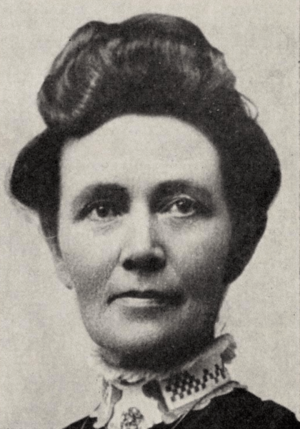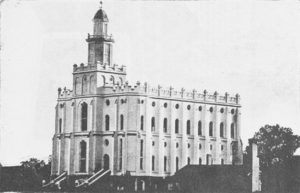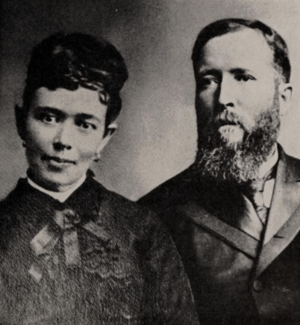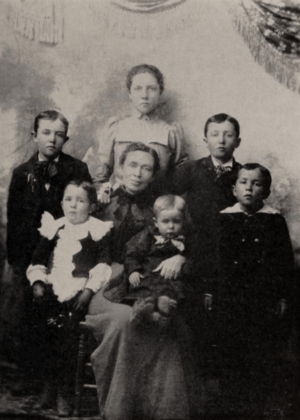Ida Hunt Udall facts for kids
Quick facts for kids
Ida Hunt Udall
|
|
|---|---|

Udall in 1905
|
|
| Born |
Ida Frances Hunt
March 8, 1858 Hamilton Fort, Utah, U. S.
|
| Died | April 26, 1915 (aged 57) Hunt, Arizona, U. S.
|
| Burial place | Saint Johns Cemetery, St. Johns, Arizona |
| Known for |
|
|
Notable work
|
Personal diary (compiled in Mormon Odyssey: The Story of Ida Hunt Udall, Plural Wife) |
| Spouse(s) |
|
Ida Frances Hunt Udall (March 8, 1858 – April 26, 1915) was an American diarist, homesteader, and teacher. She lived in the Utah and Arizona areas when they were still territories of the United States.
Ida was a member of the Church of Jesus Christ of Latter-day Saints (often called the LDS Church or Mormon Church). She was part of the church's historical practice of plural marriage. This meant she was the second wife of David King Udall, a church leader, and a co-wife with his first wife, Ella Stewart Udall, and later with Mary Ann Linton Morgan Udall.
In the 1880s, the U.S. government was prosecuting people who practiced plural marriage. Ida Udall went into hiding during this time. This practice was known as the "Mormon Underground." From 1882 to 1886, she wrote a diary about her life in plural marriage and while in hiding. This diary is considered a very important historical record. It later became the main part of a book about her life, which won an award.
Ida Udall was known as a "serene intellectual." She spent much of her adult life building a home and farm in eastern Arizona. She raised six children. Several of her children grew up to have important careers in politics.
Contents
Early Life and Education
Childhood in Utah
Ida Frances Hunt was born on March 8, 1858, in Hamilton Fort, Utah. She was the oldest child of John and Lois B. Pratt Hunt. Her parents were members of the Church of Jesus Christ of Latter-day Saints, and they raised Ida in their faith.
The Hunt family lived in Iron County, Utah, for about a year. Then they moved to San Bernardino, California, where two of Ida's sisters were born. In 1863, when Ida was five, her family moved to Beaver, Utah. Her grandmother, Louisa Barnes Pratt, lived there. In November 1869, when Ida was eleven, she was baptized into the LDS Church in the Beaver River.
Learning and Teaching
Ida received her education while growing up in Beaver, Utah. She made many friends who stayed with her throughout her life. When Ida was thirteen, her father paid for her and her sisters to attend a local school. Ida continued her schooling until she was sixteen.
Around 1872 or 1873, Ida started working as a bookkeeper at a local wool mill. In 1875, she joined the Beaver Literary Association. In April of that year, at age seventeen, she started her own school for children. She taught classes and managed the school's money herself. In November 1875, her family moved from Beaver to Sevier County, Utah. Ida continued her teaching career there. She taught in a log-cabin school in Joseph City, Utah, and later in Monroe, Utah.
Young Adulthood and New Beginnings
Travels to New Mexico and Arizona
In February 1877, Ida's family moved again, this time to New Mexico. On their journey, they passed through Washington and St. George, Utah. While in St. George in late February, Ida and her sister May received their endowments in the St. George Temple.
The family traveled for about three months. Ida and May helped by driving one of the animal teams during the trip. They arrived in San Lorenzo, New Mexico, on May 10, 1877. They stayed there for three weeks before moving to the Savoia Valley. This valley was a diverse community where Latter-day Saints, Mexicans, Navajo, and Zuni people lived near each other. While living in Savoia, Ida learned Spanish. She also taught her younger brothers and sisters in a small school she set up. She earned money by working as a seamstress.
In late 1878, the LDS Church asked Ida's father, John Hunt, to serve as a bishop in Snowflake, Arizona. The family moved again. This time, Ida did not go with them. She moved back to Beaver, Utah, in November 1878, to live with her grandmother.
Church Service and Courtship
In Beaver, the local church leaders asked Ida to serve as a counselor (an advisor) in the Young Ladies Mutual Improvement Association (YLMIA). Ida supported herself by sewing and typing up court records. She also enjoyed a busy social life, attending concerts, parties, and other gatherings. She reconnected with Johnny Murdock, who became a serious suitor.
In April 1880, Ida's family asked her to join them in Snowflake, Arizona. She agreed. Johnny Murdock proposed marriage to Ida in 1881. However, Ida ended their relationship. She wanted a plural marriage, which was a religious practice for some Latter-day Saints at the time. Johnny Murdock did not support this practice.
Plural Courtship and Engagement
While in Snowflake, Ida met David King Udall. He was a Latter-day Saint bishop in St. Johns, Arizona. David needed a clerk for a church-supported store and wanted someone who spoke Spanish. He hired Ida in the fall of 1881. Ida moved to St. Johns and lived with David, his wife Ella Stewart Udall, and their baby daughter, Pearl.
Ida and David were attracted to each other. That winter, with Ella's permission, David asked Ida if she would consider marrying him as a plural wife. Ida respected Ella deeply. She moved back to Snowflake and continued teaching. From there, in January 1882, Ida wrote to Ella, asking for permission to marry David. Ella replied in March, giving her consent, though she was a little hesitant.
David, Ella, and Pearl Udall met Ida in Snowflake. On May 6, 1882, the four of them left for St. George, Utah. They planned to be married in the temple there.
Early Marriage and Challenges
A New Beginning
Ida began writing a diary on the day she and the Udalls left for their wedding. Her diary was both a personal journal and a way to record the history of the Latter-day Saints. She used beautiful language and storytelling in her writing. She often described David Udall as a "strong male hero" and her life as a "heroine's quest for a happy marriage and family."
Ida and the Udalls traveled along the "Honeymoon Trail" to St. George. Ida was careful not to upset Ella, who was still unsure about the plural marriage. After a three-week trip, they arrived in St. George. Ida Hunt married David Udall in the St. George Temple on May 25, 1882, with Ella present.
After the wedding, Ida and Ella started to become closer. They talked together on their wedding night and continued their private conversations on the way back to St. Johns. The Udall family also visited Ella's relatives for two weeks. Ida became part of the family and its network of plural wives. She and Ella began to get along better.
Ida stayed with her father for the summer. On August 25, 1882, she moved back to St. Johns. She began living in the same house as David, Ella, and Pearl. Ida and Ella worked together on community projects, like a local May Day celebration in 1884.
Life in St. Johns was not always easy. The Latter-day Saints were new to the town. Some older residents did not like the Mormons being there. This was due to religious differences and competition in business and politics. Ida Udall felt uncomfortable because of this unfriendly feeling.
The Mormon Underground
In mid-1884, David Udall was accused of practicing plural marriage. A federal law from 1862 had made plural marriage illegal in U.S. territories. To avoid being called to court to testify against him, Ida Udall went into hiding for over two years. This was part of the "Mormon Underground."
The "Mormon Underground" was a way for Latter-day Saints to avoid arrest or court orders. It involved moving often, living in secret, keeping marriages and pregnancies quiet, and sometimes using false names. Ida Udall went into hiding to avoid being used as evidence against David. She left St. Johns with three other plural wives and went to Snowflake.
In August, federal marshals looked for Ida Udall at the Udall home in St. Johns. They questioned four-year-old Pearl, who said she didn't know where Ida was. On September 28, Ida left town. She eventually went to live with David Udall's parents in Nephi, Utah. Because prosecutors could not find Ida to testify, they could not prove the plural marriage charge against David.
Ida stayed in hiding for over two years. She gave birth to her first child with David, a daughter named Pauline, while she was in hiding. During this time, Ida sometimes stayed with David's parents. She relied heavily on friends and other Latter-day Saint women. They helped her find jobs, childcare, social connections, and emotional support. To support herself, Ida often sewed and kept financial records. She even briefly worked typing county records.
To keep their relationship secret, Ida communicated with David through Ella. David even wrote as if he and Ida were siblings. This made Ida feel lonely and frustrated because she was not openly acknowledged as his wife.
In 1885, David Udall was wrongly convicted and imprisoned for lying under oath. This was because of anti-plural marriage efforts in St. Johns. However, officials in St. Johns County wrote to Grover Cleveland, the President of the United States, asking him to pardon David. President Cleveland pardoned David in 1885. The plural marriage charge was dropped in 1886. Ida Udall eventually returned to eastern Arizona from Utah. She stopped writing in her diary in November of that year.
Ida and her daughter did not immediately return to St. Johns. They stayed with two of Ida's sisters in Snowflake until March 1888. Then, Ida moved to a farm in Round Valley, Arizona, that David and his brother had bought. Ella Udall and her children visited that summer. It was the first time Ida and Ella had seen each other in four years.
Ella still had mixed feelings about plural marriage. When David had money problems taking care of the whole family, he temporarily had Ida move back in with her parents in Snowflake. He was afraid of "offending Ella." Ida's place in the household remained uncertain after that. For two years, Ida and her children moved back and forth between Snowflake and Round Valley. Ella and her children moved between Round Valley and St. Johns.
Homesteading and Later Life
In 1890, the leader of the LDS Church, Wilford Woodruff, issued a statement called the 1890 Manifesto. In this statement, he publicly advised Latter-day Saints to follow federal laws against plural marriage. This meant the church no longer officially supported the practice.
The Udalls lived as one family in a single home during the winter of 1891–1892. But in the spring, David decided that following the 1890 Manifesto meant not living with plural wives. He moved Ida Udall to a farm in Eagar, Arizona. She ran a store there, and he visited occasionally. However, in July 1892, church leaders told him to remain a family. David then reconnected with Ida Udall. Still, for most of the rest of Ida's life, David mainly lived with Ella. Ida Udall managed the farm on her own.
Around 1900, Ida Udall got her own homestead (a piece of land) in Greer Valley, Arizona. This area was later called Hunt Valley. She started living there in the spring of 1902. Ida and her sons worked the land. They started in a tent and eventually built a house. Over the years, she grew a garden, raised grain, and kept pigs, cows, and chickens. She made cheese, butter, and hay. She also managed the property as a stop for mail carriers.
Ida continued to use her business and bookkeeping skills. She handled the money for the Hunt ranch. She also wrote David's business and church letters for him. Even with all these responsibilities, Ida was a "serene intellectual." She supported culture and education as a teacher and musician.
Ida had six children with David. For the most part, she raised them on her own while David mostly lived with Ella. In May 1903, church leaders encouraged David Udall to marry Mary Ann Linton Morgan as a plural wife. Mary Ann was a widow whose husband had died in 1894. Ida Udall was a close friend of Mary Ann's and supported the marriage. Ella did not feel the same way. David married Mary Ann in 1903. Mary Ann and her three young sons began living with Ida Udall and her children at Hunt on December 23 of that year. Ida and Mary Ann had been friends for years, and they got along well as co-wives living together. They lived together until 1906, when Mary Ann bought her own house and moved into it.
Between 1906 and 1908, Ida Udall had three strokes. The last one paralyzed her left side. Her daughter Pauline took care of her. Pearl, who was studying to be a doctor, took time off from her studies to help. After this, Ida and Pauline lived in Hunt Valley, St. Johns, and Snowflake. Ella Udall's feelings toward Ida became warmer, and their relationship improved.
Seven years after her third stroke, Ida Udall died in Hunt Valley on April 26, 1915. She was at home with her daughter Pauline. She was buried in St. Johns.
Legacy
Family Influence
Many of Ida Udall's children became important figures in Western communities and politics. Three of her sons—John Hunt Udall, Jesse Addison Udall, and Don Taylor Udall—served in the Arizona state legislature. John Hunt Udall was nominated for governor twice and later became the mayor of Phoenix, Arizona. John's son, John Nicholas Udall, also became mayor of Phoenix for several terms.
Don Taylor and Jesse Addison were also judges in Navajo County and Graham County. In 1960, Jesse became a judge on the Arizona Supreme Court, serving for eleven years. Pearl Udall moved to Salt Lake City, Utah, and opened a successful medical practice. Pauline stayed in northeastern Arizona. She served for seventeen years as the president of the LDS Church's Snowflake Stake Primary Association (a children's organization). Pauline's husband, Asahel Henry Smith, admired Ida Udall and often shared stories from her life.
Ida Udall was the grandmother of Maria S. Ellsworth, who wrote her biography. Maria was a schoolteacher and a book review author. Ida was also the great-grandmother of Milan Smith, a judge on the United States Court of Appeals for the Ninth Circuit. She was also the great-great-grandmother of novelist Brady Udall, who wrote The Lonely Polygamist.
Ida's Diary
The diary Ida Udall kept during the first four years of her marriage is a "major contribution to Mormon pioneer literature." It is considered an important record of life in plural marriage. It is also seen as a well-written autobiography that shows creativity and literary skill. The diary served as both a "personal resource" and a "public record."
Historian Charles S. Peterson described Ida's writing as "outstanding among" Mormon women's diaries. He said it was "written with feeling and perception." Another historian, Peggy Pascoe, called it "riveting reading." Ida's writings helped to describe the experiences of pioneer women in Arizona.
Ida Udall's diary is the main part of a biography written by Maria S. Ellsworth. The book, called Mormon Odyssey: The Story of Ida Hunt Udall, Plural Wife, was published in 1992. It includes the full text of Ida's diary and her unfinished memoir, along with Ellsworth's biographical writing. The book won the Mormon History Association's Best Biography Award.
See also
- Mormon literature
- Northern Arizona
- The Church of Jesus Christ of Latter-day Saints in Arizona
- Udall family
Images for kids







